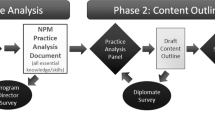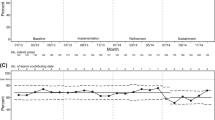Abstract
Objective
Measure variation in delivery room supervision provided by neonatologists using hypothetical scenarios and determine the factors used to guide entrustment decisions.
Study design
A survey was distributed to members of the American Academy of Pediatrics Section on Perinatal Pediatrics. Neonatologists were presented with various newborn resuscitation scenarios and asked to choose the level of supervision they thought appropriate and grade factors on their importance in making entrustment decisions.
Results
There was significant variation in supervision neonatologists deemed necessary for most scenarios (deviation from the mode 0.36–0.69). Post-graduate year of training and environmental circumstances influence the amount of autonomy neonatologists grant trainees. Few neonatologists have objective assessment of a trainees’ competence in neonatal resuscitation available to them and most never document how the trainee performed.
Conclusion
Delivery room supervision is often determined by subjective evaluation of trainees’ competence and may not provide a level of supervision congruent with their capability.
This is a preview of subscription content, access via your institution
Access options
Subscribe to this journal
Receive 12 print issues and online access
$259.00 per year
only $21.58 per issue
Buy this article
- Purchase on Springer Link
- Instant access to full article PDF
Prices may be subject to local taxes which are calculated during checkout
Similar content being viewed by others
References
Halamek LP, Kaegi DM. Who’s teaching neonatal resuscitation to housestaff? Results of a national survey. Pediatrics. 2001;107:249–55.
Pastores SM, O’Connor MF, Kleinpell RM, Napolitano L, Ward N, Bailey H, et al. The Accreditation Council for Graduate Medical Education resident duty hour new standards: history, changes, and impact on staffing of intensive care units. Crit Care Med. 2011;39:2540–9.
Drolet BC, Whittle SB, Khokhar MT, Fischer SA, Pallant A. Approval and perceived impact of duty hour regulations: survey of pediatric program directors. Pediatrics. 2013;132:819–24.
Pediatrics TABo. Entrustable professional activities for general pediatrics. https://www.abp.org/entrustable-professional-activities-epas.
Chan LC, Hey E. Can all neonatal resuscitation be managed by nurse practitioners? Arch Dis Child Fetal Neonatal Ed. 2006;91:F52–5.
Ten Cate O, Hart D, Ankel F, Busari J, Englander R, Glasgow N, et al. Entrustment decision making in clinical training. Acad Med. 2016;91:191–8.
El-Haddad C, Damodaran A, McNeil HP, Hu W. The ABCs of entrustable professional activities: an overview of ‘entrustable professional activities’ in medical education. Intern Med J. 2016;46:1006–10.
Wyckoff MH, Aziz K, Escobedo MB, Kapadia VS, Kattwinkel J, Perlman JM, et al. Part 13: neonatal resuscitation: 2015 American Heart Association Guidelines Update for cardiopulmonary resuscitation and emergency cardiovascular care (Reprint). Pediatrics. 2015;136:S196–218.
Weiner GM, Zaichkin J, Kattwinkel J. American Academy of Pediatrics, American Heart Association. Textbook of neonatal resuscitation. 7th edition. Elk Grove Village: IL: American Academy of Pediatrics; 2016. p. 313
Sterkenburg A, Barach P, Kalkman C, Gielen M, ten Cate O. When do supervising physicians decide to entrust residents with unsupervised tasks? Acad Med. 2010;85:1408–17.
Choo KJ, Arora VM, Barach P, Johnson JK, Farnan JM. How do supervising physicians decide to entrust residents with unsupervised tasks? A qualitative analysis. J Hosp Med. 2014;9:169–75.
Dijksterhuis MG, Voorhuis M, Teunissen PW, Schuwirth LW, ten Cate OT, Braat DD, et al. Assessment of competence and progressive independence in postgraduate clinical training. Med Educ. 2009;43:1156–65.
Kennedy TJ, Regehr G, Baker GR, Lingard L. Point-of-care assessment of medical trainee competence for independent clinical work. Acad Med. 2008;83:S89–92.
DeMeo SD, Katakam L, Goldberg RN, Tanaka D. Predicting neonatal intubation competency in trainees. Pediatrics. 2015;135:e1229–36.
ten Cate O, Snell L, Carraccio C. Medical competence: the interplay between individual ability and the health care environment. Med Teach. 2010;32:669–75.
Cusack J, Fawke J. Neonatal resuscitation: are your trainees performing as you think they are? A retrospective review of a structured resuscitation assessment for neonatal medical trainees over an 8-year period. Arch Dis Child Fetal Neonatal Ed. 2012;97:F246–8.
Rubio-Gurung S, Putet G, Touzet S, Gauthier-Moulinier H, Jordan I, Beissel A, et al. In situ simulation training for neonatal resuscitation: an RCT. Pediatrics. 2014;134:e790–7.
Finan E, Bismilla Z, Campbell C, Leblanc V, Jefferies A, Whyte HE. Improved procedural performance following a simulation training session may not be transferable to the clinical environment. J Perinatol. 2012;32:539–44.
Sawyer T, White M, Zaveri P, Chang T, Ades A, French H, et al. Learn, see, practice, prove, do, maintain: an evidence-based pedagogical framework for procedural skill training in medicine. Acad Med. 2015;90:1025–33.
Education ACfGM. Common Program Requirements. https://assets.fridgecms.com/81a7119e-968c-425c-b67c-1cc44e028d44/CPRs_Section%20VI_with-Background-and-Intent_2017-01.pdf.
Komatsu R, Kasuya Y, Yogo H, Sessler DI, Mascha E, Yang D, et al. Learning curves for bag-and-mask ventilation and orotracheal intubation: an application of the cumulative sum method. Anesthesiology. 2010;112:1525–31.
Phillips AW, Artino AR Jr. Lies, damned lies, and surveys. J Grad Med Educ. 2017;9:677–9.
Sullivan GM, Artino AR Jr. How to create a bad survey instrument. J Grad Med Educ. 2017;9:411–5.
Acknowledgements
Statistical analysis completed by George J. Eckert, MAS, Indiana University. This project was funded with support from the Indiana Clinical and Translational Sciences Institute, in part by Grant Number UL1TR001108 from the National Institutes of Health, National Center for Advancing Translational Sciences, Clinical and Translational Sciences Award. The sponsor had no role in the study design, collection, analysis or interpretation of data. This work was initially developed as part of the Association of Pediatric Program Directors’ Leadership in Educational Academic Development (APPD LEAD) program.
Author information
Authors and Affiliations
Corresponding author
Ethics declarations
Conflict of interest
The authors declare that they have no conflict of interest.
Rights and permissions
About this article
Cite this article
Kane, S.K., Lorant, D.E. The amount of supervision trainees receive during neonatal resuscitation is variable and often dependent on subjective criteria. J Perinatol 38, 1081–1086 (2018). https://doi.org/10.1038/s41372-018-0137-4
Received:
Revised:
Accepted:
Published:
Issue Date:
DOI: https://doi.org/10.1038/s41372-018-0137-4
This article is cited by
-
Fundamentals of designing high-quality surveys: revisiting neonatal perinatal medicine survey applications
Journal of Perinatology (2023)
-
Essentials of Neonatal-Perinatal Medicine fellowship: an overview
Journal of Perinatology (2022)



